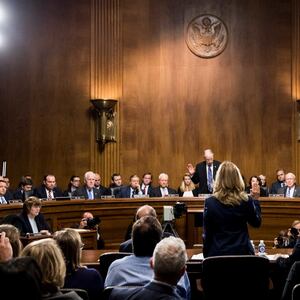When the first woman came forward with sexual assault allegations against Virginia Lt. Gov. Justin Fairfax, the young, rising black star who appeared poised to take the governorship from the blackface-scandal-scarred Gov. Ralph Northam, there was mostly silence from Virginia and national Democrats. That changed after a second accuser came forward Friday, and The New York Times interviewed five friends of the first accuser, Dr. Vanessa Tyson, who said that she had previously told each of them about her encounter with Fairfax.
One question is why many of the same Democrats who’d been so quick to call out Brett Kavanaugh when he was a Supreme Court nominee similarly accused of assault by a respected professor said little or nothing about Fairfax (who, by the way, is now being represented by the same law firm that had worked with Kavanaugh).
The situations aren’t entirely the same, but one rule for a common standard in this MeToo era following a credible accusation is that you should then be probed, not promoted.
ADVERTISEMENT
The Fairfax response was complicated by all the other messy news in Virginia, starting with Northam admitting and then denying that he was the person wearing blackface or a KKK outfit on a picture on his medical school yearbook page showing both, and then utterly botching multiple attempts at what should have been an acknowledgment and apology. The state attorney general, Mark Herring, then confessed that he, too, once wore blackface. He handled the apology part of the confession better, and theoretically would be next in line for the governorship if both Northam and Fairfax resign.
If we’re being coldly honest about how politics work, it’s difficult to ask the black politician to step down, while the ones who wore blackface stay on. And it’s difficult to ask all three to resign when a Republican is fourth in line to become governor.
The Gov. Fairfax hype cooled down considerably after the first assault accusation, even as many Democrats in the state were mealy-mouthed or mum about what should happen next. And Northam insists he isn’t stepping down, making the question of whether Fairfax deserves a promotion to governor basically moot.
Kavanaugh, of course, was promoted despite Dr. Christine Blasey Ford’s harrowing account of her assault. That can’t be the standard going forward, and that a Republican got away with something shouldn’t determine how Democrats—or anyone with integrity—proceeds in these circumstances.
Fairfax should resign. Absent that, he must be investigated. But by whom? When men are credibly accused of crimes against women that cannot be pressed in a courtroom because of the passage of time, how do we give them a public hearing to hold them to account? These are questions that I hope the MeToo era is forcing us to consider and offer a fair and consistent answers to.
This time, it appears that the investigation is once again being conducted in public, by the media and the accusers’ lawyers. Since Fairfax’s second accuser, Meredith Watson, has come forward, fellow academics have come out in support of Dr. Tyson’s allegations, Democrats—including five Congress members from Virginia— are lining up to call for Fairfax’s ouster while one Democratic Virginia state delegate is reportedly threatening to file articles of impeachment against Fairfax if he doesn’t resign by Monday.
Uncomfortable questions remain: How many women need to say the same man hurt them before we believe their accounts? Why was one not enough? How do we investigate claims of years-old conduct, and who should do the investigating?
In this case, The Washington Post had looked into Dr. Tyson’s story and not reported on it.
They did so only after the accusation had first been reported by the same conservative news site that had first reported on Northam’s year book, and Fairfax then said the Post’s decision not to print the woman’s story showed it wasn’t credible. That compelled the paper to report on its own reporting:
The Post could not find anyone who could corroborate either version. The Post did not find “significant red flags and inconsistencies within the allegations,” as the Fairfax statement incorrectly said.
While the Post was unable to corroborate Tyson’s story before it became public, The New York Times subsequently found six people who testified to Tyson having talked about the assault before this year.
Investigating sexual assault has always been, and remains, complicated. But if the past two years have shown us anything, it’s that digging into these complex stories—rather than dismissing them as too difficult to report out—is more often worthwhile than not.








